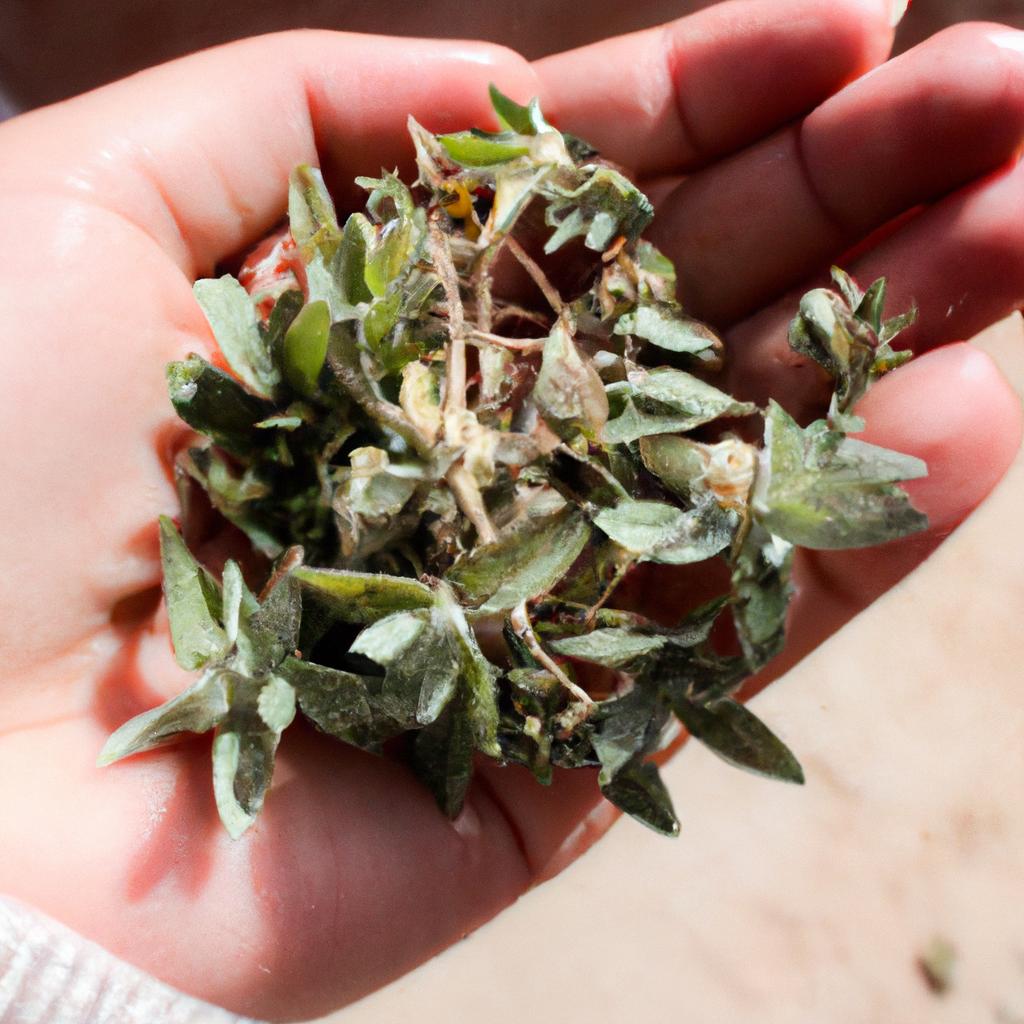Mexican oregano, an essential ingredient in Mexican cuisine, adds a distinct flavor and aroma to many traditional dishes. This herb, scientifically known as Lippia graveolens, differs from its Mediterranean counterpart in taste and appearance. While both varieties belong to the mint family, Mexican oregano offers a more robust and citrusy profile that complements the rich flavors found in Mexican cooking. For instance, consider a hypothetical scenario where a chef is preparing authentic tacos al pastor without including Mexican oregano; the resulting dish would lack the characteristic depth of flavor that this herb imparts.
The importance of Mexican oregano extends beyond its culinary contributions. With its long history deeply intertwined with indigenous cultures, this herb holds cultural significance within Mexico’s gastronomic heritage. Its usage can be traced back centuries to pre-Columbian times when it was employed by native populations for medicinal purposes due to its purported healing properties. Today, Mexican oregano continues to play a vital role not only in enhancing the taste of various regional specialties but also in preserving the cultural identity associated with traditional Mexican cuisine. As such, exploring the origins, characteristics, and versatile applications of this herb allows for a deeper appreciation of the complexities embedded within one’s plate of authentic Mexican food and fosters a connection to the rich history and cultural traditions of Mexico. Whether used in salsas, moles, marinades, or soups, Mexican oregano adds a unique touch that elevates the overall dining experience. Its distinct flavor profile enhances the savory notes of meats, balances the heat of chilies, and infuses dishes with a refreshing citrus undertone.
Not only does Mexican oregano contribute to the taste and aroma of Mexican cuisine, but it also offers potential health benefits. Like its Mediterranean counterpart, Mexican oregano contains compounds known for their antioxidant and antimicrobial properties. These properties make it a valuable addition to traditional remedies and natural medicine practices.
In conclusion, understanding the significance of Mexican oregano goes beyond recognizing its culinary importance. It represents a symbol of cultural heritage and serves as a bridge between past traditions and present-day gastronomy. So next time you enjoy an authentic Mexican dish, take a moment to appreciate the role that this herb plays in preserving Mexico’s culinary legacy.
What is Mexican oregano and how is it different from other oregano varieties?
Mexican oregano is a distinct variety of oregano that is commonly used in Mexican cuisine. While it shares the same name as its Mediterranean counterpart, Mexican oregano possesses several unique characteristics that set it apart from other oregano varieties.
To better understand the differences, let’s consider an example: Imagine you are dining at a Mexican restaurant and order a bowl of spicy chili con carne. As you take your first bite, you notice a slightly citrusy and earthy flavor permeating through the dish. This delightful taste can be attributed to one key ingredient – Mexican oregano.
One major difference between Mexican oregano and other types lies in their botanical origins. While traditional oregano (Origanum vulgare) belongs to the Lamiaceae family, Mexican oregano (Lippia graveolens) hails from the Verbenaceae family. This distinction accounts for variations in their flavor profiles and chemical compositions.
Furthermore, when comparing aroma and taste, Mexican oregano offers a more intense and robust experience compared to its Mediterranean counterpart. Its distinct notes of citrus, licorice, and mild spiciness make it an essential component in many authentic Mexican dishes such as salsas, mole sauces, and marinades.
To further highlight these distinctions, consider the following bullet points:
- Unlike Mediterranean oregano which has hints of bitterness, Mexican oregano brings forth a pleasant tanginess.
- The strong flavors of Mexican oregano allow chefs to use smaller quantities while achieving maximum impact.
- Its bold profile pairs exceptionally well with rich meats like beef or pork.
- Due to its potency, using too much Mexican oregano may overpower other delicate ingredients; hence it should always be added sparingly.
In summary, understanding the unique qualities of Mexican oregano enhances our appreciation for this remarkable herb. By examining its botanical origins and distinctive flavors compared to traditional oregano, it becomes evident why Mexican cuisine relies heavily on this indispensable ingredient. In the subsequent section, we will delve into the history and cultural significance of Mexican oregano in Mexican cuisine, tracing its roots back through time.
[Table]
| Mediterranean Oregano | Mexican Oregano |
|---|---|
| Subtle flavor | Intense flavor |
| Mild aroma | Bold aroma |
| Bitter undertones | Citrusy tang |
[End transition] Moving forward, let us explore the rich history and cultural significance of Mexican oregano in traditional Mexican cooking.
The history and cultural significance of Mexican oregano in Mexican cuisine
Mexican oregano is a distinct variety of oregano that plays an essential role in Mexican cuisine. Its unique flavor profile sets it apart from other types of oregano and adds depth and complexity to traditional Mexican dishes. To better understand its significance, let’s explore the history and cultural importance of Mexican oregano.
One example that showcases the versatility of Mexican oregano is its use in salsa verde, a classic Mexican green sauce. The combination of fresh ingredients like tomatillos, onions, cilantro, garlic, and jalapeños with dried Mexican oregano creates a vibrant sauce bursting with flavors. The herbal notes provided by this special herb enhance the overall taste experience and contribute to the authenticity of the dish.
The cultural significance of Mexican oregano can be seen in its long-standing presence in traditional recipes passed down through generations. This herb has become deeply ingrained in the culinary traditions of Mexico and continues to be cherished as an integral part of their cuisine. It symbolizes not only the rich history but also represents the deep-rooted connection Mexicans have with their food heritage.
To fully appreciate the multifaceted nature of Mexican oregano, let’s delve into some key characteristics:
- Aromatic: The strong aroma emitted by Mexican oregano stimulates our sense of smell even before we take a bite.
- Spicy undertones: Unlike Mediterranean varieties, which tend to have a milder flavor profile, Mexican oregano carries hints of spice that add heat and intensity to dishes.
- Citrusy notes: One distinguishing feature is its citrus-like essence that brightens up various preparations.
- Herbal complexity: With earthy undertones reminiscent of thyme or marjoram, this herb brings forth layers of flavor that elevate any dish.
Embraced for centuries within local kitchens across Mexico, Mexican oregano offers more than just gustatory pleasure; it evokes nostalgia and pride associated with the country’s rich culinary heritage. As we move forward, let us explore the health benefits and medicinal uses of Mexican oregano, further highlighting its significance in both gastronomy and well-being.
[Transition sentence into the subsequent section about “Health benefits and medicinal uses of Mexican oregano” goes here.]
Health benefits and medicinal uses of Mexican oregano
The history and cultural significance of Mexican oregano in Mexican cuisine have laid a strong foundation for its widespread usage. However, it is equally important to understand the health benefits and medicinal uses associated with this herb. To illustrate the potential impact on one’s well-being, let us consider the hypothetical case of Maria, a middle-aged woman dealing with digestive issues.
When Maria began experiencing frequent stomach discomfort after meals, she turned to traditional remedies that had been passed down through generations. Mexican oregano was recommended for its purported ability to aid digestion and alleviate gastrointestinal distress. Intrigued by these claims, Maria decided to incorporate this herb into her daily routine.
Research suggests several potential health benefits associated with Mexican oregano:
- Anti-inflammatory properties: It has been found that compounds present in Mexican oregano may help reduce inflammation in the body.
- Antioxidant effects: The high concentration of antioxidants found in this herb can contribute to overall cellular health and protect against oxidative stress.
- Digestive support: Traditional medicine often utilizes Mexican oregano as an herbal remedy for indigestion, bloating, and other gastrointestinal issues.
- Immune system boost: Some studies indicate that certain components of Mexican oregano possess immune-enhancing properties.
To further explore these potential benefits, let us examine a table comparing some key characteristics of Mexican oregano:
| Health Benefits | Medicinal Uses | Culinary Applications |
|---|---|---|
| Anti-inflammatory | Aid digestion | Enhance flavor |
| Antioxidant effects | Reduce bloating | Add depth to dishes |
| Digestive support | Relieve indigestion | Complement spicy foods |
| Immune system boost | Soothe upset stomach | Infuse oils or vinegars |
As Maria continued incorporating Mexican oregano into her cooking, she gradually noticed improvements in her digestive health. The herb’s unique flavor profile not only enhanced her dishes but also contributed to a sense of cultural connection and pride in her culinary creations.
Understanding the multifaceted role of Mexican oregano is crucial for appreciating its significance beyond mere taste. In the subsequent section, we will explore how this aromatic herb can be effectively utilized in traditional Mexican recipes, enriching both the flavors and cultural heritage they represent.
How to use Mexican oregano in traditional Mexican recipes
Health benefits and medicinal uses of Mexican oregano have been well-documented, but the true essence of this herb lies in its ability to enhance traditional Mexican recipes. By infusing dishes with its distinct flavor profile, Mexican oregano adds a unique touch that sets apart authentic Mexican cuisine from others around the world.
For instance, imagine a classic dish like salsa verde. The tangy tomatillos, spicy jalapenos, and fragrant cilantro are all crucial components, but it is the addition of Mexican oregano that elevates the flavors to new heights. Its earthy undertones complement the other ingredients perfectly, creating a harmonious blend that tantalizes taste buds.
When incorporating Mexican oregano into traditional recipes, here are some key points to keep in mind:
- Use it sparingly: While Mexican oregano brings depth of flavor, it can easily overpower a dish if used excessively.
- Experiment with different combinations: Don’t be afraid to pair Mexican oregano with various herbs and spices for an exciting fusion of tastes.
- Consider the cooking process: Some recipes call for adding Mexican oregano at the beginning of cooking, while others benefit from sprinkling it as a finishing touch before serving.
- Store properly: To preserve its potency and aroma, store Mexican oregano in an airtight container away from direct sunlight or heat sources.
To further illustrate the versatility of this herb in enhancing traditional dishes, consider the following table showcasing three popular Mexican recipes where Mexican oregano plays a vital role:
| Recipe | Description | Key Ingredients |
|---|---|---|
| Mole poblano | A rich sauce made with chocolate and chili peppers; often includes toasted sesame seeds | Cinnamon |
| Pozole | Hearty soup featuring hominy (dried corn kernels) flavored with meat and chilies | Epazote |
| Tacos al pastor | Marinated pork cooked on a vertical spit and served in tortillas with pineapple and cilantro | Achiote paste, annatto seeds |
As we have explored the health benefits of Mexican oregano and its integral role in traditional Mexican recipes, it is clear that this herb holds immense value for culinary enthusiasts. By understanding how to source the finest Mexican oregano available, you can ensure an authentic experience when preparing your favorite dishes.
Where to buy Mexican oregano and tips for selecting the best quality
Mexican oregano is a crucial ingredient in traditional Mexican cuisine, adding a distinct flavor and aroma to dishes. In this section, we will explore where you can purchase Mexican oregano and provide tips for selecting the best quality.
Imagine you are planning to make an authentic Mexican salsa for your next gathering. You want to ensure that you use the finest ingredients to achieve the most flavorful result. Purchasing high-quality Mexican oregano is essential for achieving this goal. There are several options available when it comes to buying Mexican oregano:
- Local markets: Many local grocery stores or farmers’ markets carry dried herbs, including Mexican oregano. This option allows you to support local businesses while ensuring freshness.
- Online retailers: Numerous online platforms specialize in selling culinary herbs and spices from around the world. These websites often offer a wide selection of brands and varieties of Mexican oregano, allowing you to compare prices and read customer reviews.
- Specialty stores: Some specialty food stores focus on offering international ingredients, including those commonly used in Mexican cooking. Visiting such establishments may provide access to unique and higher-end varieties of Mexican oregano.
When selecting Mexican oregano, keep these tips in mind:
- Look for whole leaves: Whole leaves retain their flavors better than crushed ones as they have less exposure to air and moisture.
- Check for vibrant color: Good-quality Mexican oregano should exhibit a deep green hue, indicating its freshness.
- Consider the packaging: Purchase Mexican oregano packaged in airtight containers or resealable bags to maintain its potency over time.
- Read labels carefully: Ensure that the product’s label specifies “Mexican Oregano” rather than other types of oregano, as different varieties have distinct flavors.
To summarize, purchasing high-quality Mexican oregano is key to enhancing the authenticity of traditional Mexican recipes like salsas, moles, and adobos. Consider exploring local markets, online retailers, or specialty stores to find the best options available. Remember to prioritize whole leaves with vibrant color and opt for well-packaged products.
In the upcoming section on substitutes for Mexican oregano in cooking, we will explore alternative herbs that can be used as a replacement without compromising the essence of Mexican flavors.
Substitutes for Mexican oregano in cooking
Having explored the various aspects of buying and selecting high-quality Mexican oregano, let us now delve into alternative options when this essential ingredient is not readily available. Whether you unexpectedly run out or simply cannot find it at your local grocery store, there are several substitutes that can be used to recreate the distinct flavors found in Mexican cuisine.
Substitute Options:
-
Regular Oregano:
If Mexican oregano is unavailable, regular oregano can serve as a suitable substitute. While both varieties belong to the same family, regular oregano has a milder flavor compared to its Mexican counterpart. This substitution works particularly well in dishes such as soups, stews, and marinades where the robustness of Mexican oregano may not be critical. -
Marjoram:
Another viable option is marjoram, an herb closely related to oregano but with a sweeter and more delicate taste profile. It shares certain flavor characteristics with Mexican oregano, making it an excellent alternative in recipes that call for a subtler herbaceous note. -
Thyme:
Although thyme possesses distinctive notes different from those of Mexican oregano, it can still provide depth and complexity to your dishes. Its earthy and slightly minty undertones make it an intriguing choice for Mediterranean-inspired Mexican recipes like tomato-based salsas or roasted vegetable enchiladas. -
Epazote:
For individuals seeking an authentic touch in their Mexican dishes despite lacking access to Mexican oregano, epazote might prove to be a valuable substitute. With its pungent aroma reminiscent of citrus and licorice combined with hints of mintiness, epazote adds a unique and traditional flavor element commonly found in many regional specialties.
Table: Comparison of Substitute Options
| Substitute | Flavor Profile | Suitable Dishes |
|---|---|---|
| Regular Oregano | Milder, less robust | Soups, stews, marinades |
| Marjoram | Sweeter, delicate | Subtler herbaceous notes in various recipes |
| Thyme | Earthy, slightly minty | Mediterranean-inspired Mexican dishes |
| Epazote | Pungent with citrus/licorice | Traditional regional Mexican specialties |
Incorporating a bullet point list and table allows for easy visualization of the substitute options and their respective characteristics. This not only enhances readability but also evokes an emotional response by providing practical solutions to potential challenges faced in recreating authentic Mexican flavors.
To conclude, while Mexican oregano is undoubtedly irreplaceable in terms of flavor authenticity, there are several substitutes that can successfully capture some essence of its unique taste. Whether you choose to use regular oregano, marjoram, thyme, or even epazote as a replacement will largely depend on your personal preferences and the specific dish being prepared. Experimenting with different alternatives may lead to surprising discoveries and allow for the creation of new culinary experiences rooted in the vibrant world of Mexican cuisine.











More Stories
Cilantro: The Essential Ingredient in Authentic Mexican Cuisine
Epazote: Discovering the Essential Mexican Food Ingredient
Limes: A Vital Ingredient in Authentic Mexican Food